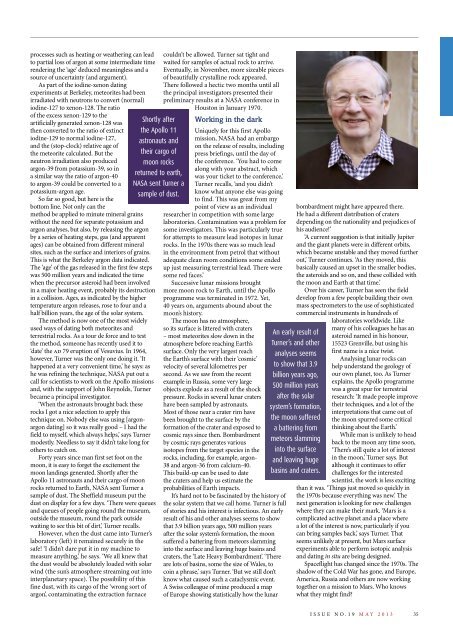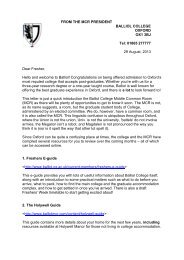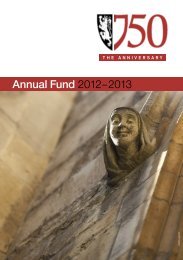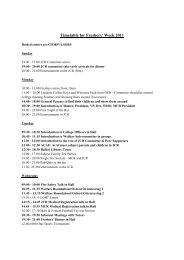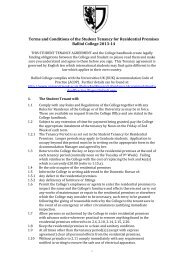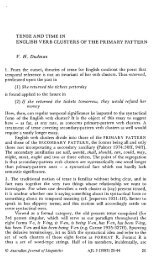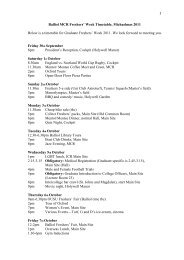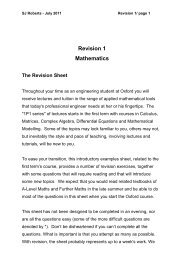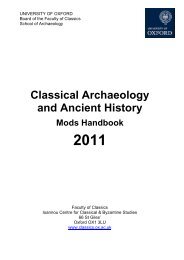Issue 19, 2013 - Balliol College - University of Oxford
Issue 19, 2013 - Balliol College - University of Oxford
Issue 19, 2013 - Balliol College - University of Oxford
Create successful ePaper yourself
Turn your PDF publications into a flip-book with our unique Google optimized e-Paper software.
processes such as heating or weathering can lead<br />
to partial loss <strong>of</strong> argon at some intermediate time<br />
rendering the ‘age’ deduced meaningless and a<br />
source <strong>of</strong> uncertainty (and argument).<br />
As part <strong>of</strong> the iodine-xenon dating<br />
experiments at Berkeley, meteorites had been<br />
irradiated with neutrons to convert (normal)<br />
iodine-127 to xenon-128. The ratio<br />
<strong>of</strong> the excess xenon-129 to the<br />
artificially generated xenon-128 was<br />
then converted to the ratio <strong>of</strong> extinct<br />
iodine-129 to normal iodine-127,<br />
and the (stop-clock) relative age <strong>of</strong><br />
the meteorite calculated. But the<br />
neutron irradiation also produced<br />
argon-39 from potassium-39, so in<br />
a similar way the ratio <strong>of</strong> argon-40<br />
to argon-39 could be converted to a<br />
potassium-argon age.<br />
So far so good, but here is the<br />
bottom line. Not only can the<br />
method be applied to minute mineral grains<br />
without the need for separate potassium and<br />
argon analyses, but also, by releasing the argon<br />
by a series <strong>of</strong> heating steps, gas (and apparent<br />
ages) can be obtained from different mineral<br />
sites, such as the surface and interiors <strong>of</strong> grains.<br />
This is what the Berkeley argon data indicated.<br />
The ‘age’ <strong>of</strong> the gas released in the first few steps<br />
was 500 million years and indicated the time<br />
when the precursor asteroid had been involved<br />
in a major heating event, probably its destruction<br />
in a collision. Ages, as indicated by the higher<br />
temperature argon releases, rose to four and a<br />
half billion years, the age <strong>of</strong> the solar system.<br />
The method is now one <strong>of</strong> the most widely<br />
used ways <strong>of</strong> dating both meteorites and<br />
terrestrial rocks. As a tour de force and to test<br />
the method, someone has recently used it to<br />
‘date’ the ad 79 eruption <strong>of</strong> Vesuvius. In <strong>19</strong>64,<br />
however, Turner was the only one doing it. ‘It<br />
happened at a very convenient time,’ he says: as<br />
he was refining the technique, NASA put out a<br />
call for scientists to work on the Apollo missions<br />
and, with the support <strong>of</strong> John Reynolds, Turner<br />
became a principal investigator.<br />
‘When the astronauts brought back these<br />
rocks I got a nice selection to apply this<br />
technique on. Nobody else was using [argonargon<br />
dating] so it was really good – I had the<br />
field to myself, which always helps,’ says Turner<br />
modestly. Needless to say it didn’t take long for<br />
others to catch on.<br />
Forty years since man first set foot on the<br />
moon, it is easy to forget the excitement the<br />
moon landings generated. Shortly after the<br />
Apollo 11 astronauts and their cargo <strong>of</strong> moon<br />
rocks returned to Earth, NASA sent Turner a<br />
sample <strong>of</strong> dust. The Sheffield museum put the<br />
dust on display for a few days. ‘There were queues<br />
and queues <strong>of</strong> people going round the museum,<br />
outside the museum, round the park outside<br />
waiting to see this bit <strong>of</strong> dirt,’ Turner recalls.<br />
However, when the dust came into Turner’s<br />
laboratory (left) it remained securely in the<br />
safe! ‘I didn’t dare put it in my machine to<br />
measure anything,’ he says. ‘We all knew that<br />
the dust would be absolutely loaded with solar<br />
wind (the sun’s atmosphere streaming out into<br />
interplanetary space). The possibility <strong>of</strong> this<br />
fine dust, with its cargo <strong>of</strong> the ‘wrong sort <strong>of</strong><br />
argon’, contaminating the extraction furnace<br />
Shortly after<br />
the Apollo 11<br />
astronauts and<br />
their cargo <strong>of</strong><br />
moon rocks<br />
returned to earth,<br />
NASA sent Turner a<br />
sample <strong>of</strong> dust.<br />
couldn’t be allowed. Turner sat tight and<br />
waited for samples <strong>of</strong> actual rock to arrive.<br />
Eventually, in November, more sizeable pieces<br />
<strong>of</strong> beautifully crystalline rock appeared.<br />
There followed a hectic two months until all<br />
the principal investigators presented their<br />
preliminary results at a NASA conference in<br />
Houston in January <strong>19</strong>70.<br />
Working in the dark<br />
Uniquely for this first Apollo<br />
mission, NASA had an embargo<br />
on the release <strong>of</strong> results, including<br />
press briefings, until the day <strong>of</strong><br />
the conference. ‘You had to come<br />
along with your abstract, which<br />
was your ticket to the conference,’<br />
Turner recalls, ‘and you didn’t<br />
know what anyone else was going<br />
to find. This was great from my<br />
point <strong>of</strong> view as an individual<br />
researcher in competition with some large<br />
laboratories. Contamination was a problem for<br />
some investigators. This was particularly true<br />
for attempts to measure lead isotopes in lunar<br />
rocks. In the <strong>19</strong>70s there was so much lead<br />
in the environment from petrol that without<br />
adequate clean room conditions some ended<br />
up just measuring terrestrial lead. There were<br />
some red faces.’<br />
Successive lunar missions brought<br />
more moon rock to Earth, until the Apollo<br />
programme was terminated in <strong>19</strong>72. Yet,<br />
40 years on, arguments abound about the<br />
moon’s history.<br />
The moon has no atmosphere,<br />
so its surface is littered with craters<br />
– most meteorites slow down in the<br />
atmosphere before reaching Earth’s<br />
surface. Only the very largest reach<br />
the Earth’s surface with their ‘cosmic’<br />
velocity <strong>of</strong> several kilometres per<br />
second. As we saw from the recent<br />
example in Russia, some very large<br />
objects explode as a result <strong>of</strong> the shock<br />
pressure. Rocks in several lunar craters<br />
have been sampled by astronauts.<br />
Most <strong>of</strong> those near a crater rim have<br />
been brought to the surface by the<br />
formation <strong>of</strong> the crater and exposed to<br />
cosmic rays since then. Bombardment<br />
by cosmic rays generates various<br />
isotopes from the target species in the<br />
rocks, including, for example, argon-<br />
38 and argon-36 from calcium-40.<br />
This build-up can be used to date<br />
the craters and help us estimate the<br />
probabilities <strong>of</strong> Earth impacts.<br />
It’s hard not to be fascinated by the history <strong>of</strong><br />
the solar system that we call home. Turner is full<br />
<strong>of</strong> stories and his interest is infectious. An early<br />
result <strong>of</strong> his and other analyses seems to show<br />
that 3.9 billion years ago, 500 million years<br />
after the solar system’s formation, the moon<br />
suffered a battering from meteors slamming<br />
into the surface and leaving huge basins and<br />
craters, the ‘Late Heavy Bombardment’. ‘There<br />
are lots <strong>of</strong> basins, some the size <strong>of</strong> Wales, to<br />
coin a phrase,’ says Turner. ‘But we still don’t<br />
know what caused such a cataclysmic event.<br />
A Swiss colleague <strong>of</strong> mine produced a map<br />
<strong>of</strong> Europe showing statistically how the lunar<br />
bombardment might have appeared there.<br />
He had a different distribution <strong>of</strong> craters<br />
depending on the nationality and prejudices <strong>of</strong><br />
his audience!’<br />
‘A current suggestion is that initially Jupiter<br />
and the giant planets were in different orbits,<br />
which became unstable and they moved further<br />
out,’ Turner continues. ‘As they moved, this<br />
basically caused an upset in the smaller bodies,<br />
the asteroids and so on, and these collided with<br />
the moon and Earth at that time.’<br />
Over his career, Turner has seen the field<br />
develop from a few people building their own<br />
mass spectrometers to the use <strong>of</strong> sophisticated<br />
commercial instruments in hundreds <strong>of</strong><br />
laboratories worldwide. Like<br />
many <strong>of</strong> his colleagues he has an<br />
asteroid named in his honour,<br />
15523 Grenville, but using his<br />
first name is a nice twist.<br />
Analysing lunar rocks can<br />
help understand the geology <strong>of</strong><br />
our own planet, too. As Turner<br />
explains, the Apollo programme<br />
was a great spur for terrestrial<br />
research: ‘It made people improve<br />
their techniques, and a lot <strong>of</strong> the<br />
interpretations that came out <strong>of</strong><br />
the moon spurred some critical<br />
thinking about the Earth.’<br />
While man is unlikely to head<br />
back to the moon any time soon,<br />
‘There’s still quite a lot <strong>of</strong> interest<br />
in the moon,’ Turner says. But<br />
although it continues to <strong>of</strong>fer<br />
challenges for the interested<br />
scientist, the work is less exciting<br />
than it was. ‘Things just moved so quickly in<br />
the <strong>19</strong>70s because everything was new.’ The<br />
next generation is looking for new challenges<br />
where they can make their mark. ‘Mars is a<br />
complicated active planet and a place where<br />
a lot <strong>of</strong> the interest is now, particularly if you<br />
can bring samples back,’ says Turner. That<br />
seems unlikely at present, but Mars surface<br />
experiments able to perform isotopic analysis<br />
and dating in situ are being designed.<br />
Spaceflight has changed since the <strong>19</strong>70s. The<br />
shadow <strong>of</strong> the Cold War has gone, and Europe,<br />
America, Russia and others are now working<br />
together on a mission to Mars. Who knows<br />
what they might find<br />
An early result <strong>of</strong><br />
Turner’s and other<br />
analyses seems<br />
to show that 3.9<br />
billion years ago,<br />
500 million years<br />
after the solar<br />
system’s formation,<br />
the moon suffered<br />
a battering from<br />
meteors slamming<br />
into the surface<br />
and leaving huge<br />
basins and craters.<br />
issue no.<strong>19</strong> MAY <strong>2013</strong><br />
35


